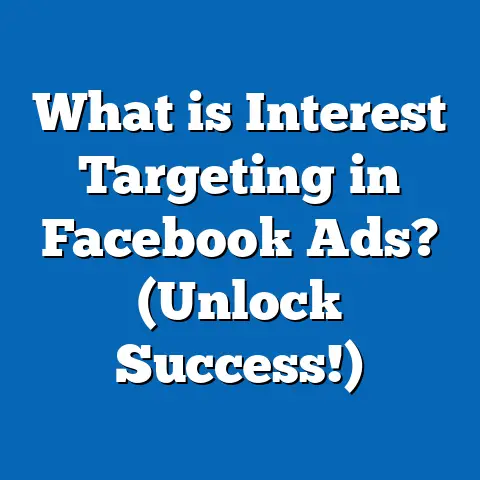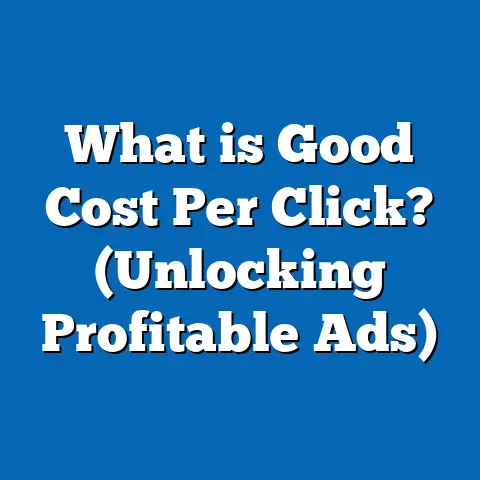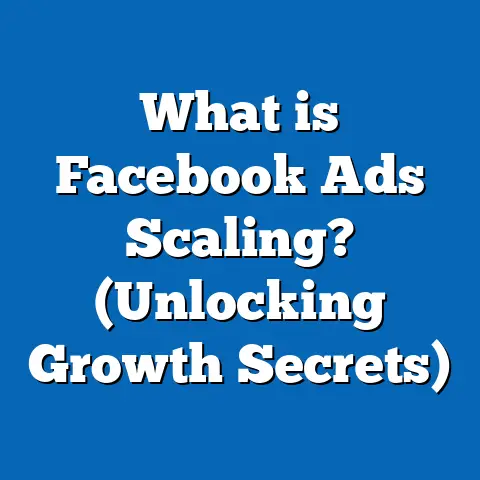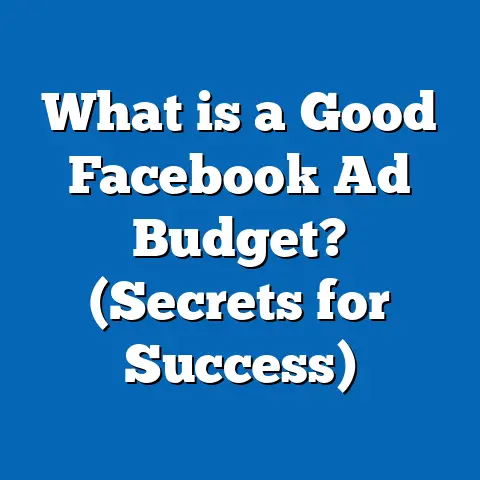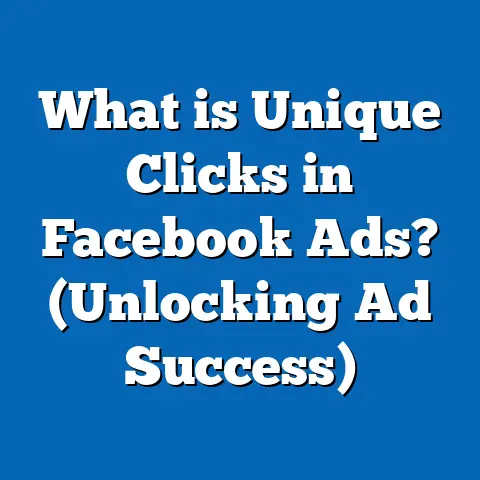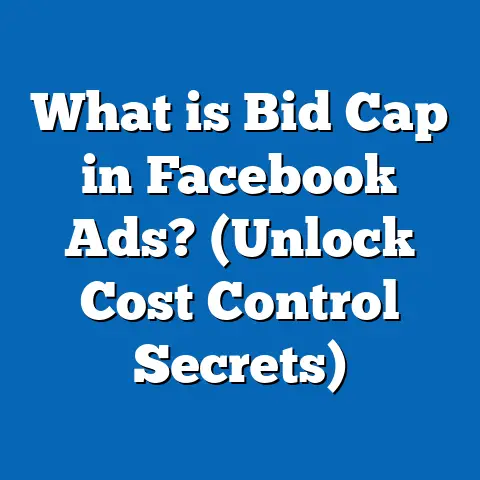What is Facebook Audience Ads? (Unlock Targeted Marketing)
Introduction: Unlocking Luxury Marketing with Facebook Audience Ads
In the high-stakes world of luxury marketing, precision is everything. When selling premium goods—whether it’s handcrafted watches, couture fashion, or exclusive travel experiences—reaching the right audience is paramount. Luxury brands cannot afford to waste impressions on uninterested users or dilute their exclusivity by targeting mass markets. Instead, they require a laser-focused advertising approach that delivers personalized messages to those most likely to appreciate and purchase their offerings.
Facebook Audience Ads provide exactly this capability. Harnessing Facebook’s unparalleled data resources and sophisticated algorithms, these ads allow brands to pinpoint audiences with remarkable accuracy. This means every dollar spent translating into meaningful engagement, increased conversion rates, and ultimately, higher revenue.
What Are Facebook Audience Ads?
Facebook Audience Ads are advertisements shown to specific groups of Facebook users based on detailed targeting parameters. Unlike generic ads that are broadcast broadly, Audience Ads focus on delivering relevant content to carefully selected segments.
The Importance of Audience Segmentation
Audience segmentation is the process of dividing the overall market into smaller groups with shared characteristics. Facebook’s platform allows advertisers to perform this segmentation at a granular level:
- Demographics such as age, gender, income, education
- Geographic location down to city or neighborhood level
- Interests and passions derived from user behavior and page likes
- Online behaviors like purchase habits and device usage
Why Precision Matters for Luxury Brands
Targeted delivery ensures that the brand’s message reaches potential buyers who are more likely to engage and convert. For luxury brands, this means:
- Maintaining a sense of exclusivity by avoiding mass-market dilution
- Ensuring that expensive ad budgets generate optimal returns
- Enhancing customer experience through relevant communications
Understanding Facebook’s Audience Targeting Options in Detail
Facebook’s advertising platform provides three primary audience types:
1. Core Audiences
Core Audiences let advertisers define target groups based on Facebook’s standard targeting criteria:
- Demographics: Age ranges (e.g., 30-55 years old), gender (e.g., women), languages spoken.
- Location: Countries, states, cities, or even radius targeting around a physical address.
- Interests: Pages liked, topics followed — for example, “luxury travel,” “fine dining,” or “sustainable fashion.”
- Behaviors: Purchase behavior, device usage (iPhone users), travel habits (frequent international travelers).
Example: A luxury hotel chain targets frequent international travelers aged 35-60 living in New York and London interested in “luxury resorts” and “fine dining.”
2. Custom Audiences
Custom Audiences enable advertisers to reconnect with people who have already interacted with their brand:
- Upload email or phone contact lists
- Website visitors tracked using Facebook Pixel
- Users who engaged with Instagram or Facebook content
- App users tracked via Facebook SDK
This audience type is powerful for retargeting warm leads or nurturing loyal customers.
Example: A high-end jewelry brand retargets website visitors who viewed but did not purchase from its online store in the last 30 days.
3. Lookalike Audiences
Lookalike Audiences help advertisers find new potential customers similar to their existing best customers. Facebook analyzes the characteristics of a source audience (such as top purchasers) and finds similar users.
Example: A premium car manufacturer creates a Lookalike Audience based on their top 5% buyers in California to reach new prospects with similar profiles.
Detailed Data Insights: Facebook Audience Ads Performance Metrics
Data from multiple industry reports highlight the effectiveness of targeted Facebook ads.
Return on Ad Spend (ROAS)
- Businesses using Custom and Lookalike Audiences report an average ROAS increase from 3:1 to as high as 7:1 (Social Media Examiner, 2023).
- Luxury brands often see even higher returns due to the high average order value (AOV).
Click-Through Rate (CTR)
- Targeted ads typically achieve CTRs between 1.5% – 3%, compared to less than 0.5% for untargeted ads.
- A well-targeted luxury campaign can reach CTRs exceeding 4%, especially when paired with compelling creative.
Cost Per Acquisition (CPA)
- Targeted campaigns reduce CPA by up to 40% according to HubSpot’s 2024 marketing report.
- Retargeting warm audiences often achieves CPA reductions of 50% or more.
Engagement Rates
- Luxury brands see elevated engagement levels when ads align closely with audience interests; engagement rates can increase by 30%-50% compared to non-targeted campaigns.
How Facebook Builds Its Audience Profiles: Technical Breakdown
Facebook’s audience targeting relies on massive data collection and advanced processing:
What Data Does Facebook Use?
- User activity on Facebook and Instagram (likes, shares, comments)
- Browsing behavior tracked via Facebook Pixel across millions of websites
- Data partnerships with third parties providing offline purchase data
- Device information including location from mobile devices
How Does Facebook Process This Data?
Machine learning algorithms analyze patterns in user behavior and attributes. These models continuously learn which traits predict engagement with certain ads.
Simplified Explanation
Imagine Facebook as a massive database cataloging billions of user profiles with detailed attributes. When you specify targeting criteria in your ad campaign, Facebook matches your parameters with the profiles in its system to deliver ads only to those who fit your ideal customer profile.
Practical Applications: Using Facebook Audience Ads for Luxury Brands
High-End Fashion Label Example
A luxury fashion label launching a new fall collection uses the following strategy:
- Define Core Audience: Urban women aged 25-45 interested in “designer brands,” “fashion magazines,” and “luxury lifestyle.”
- Build Custom Audience: Upload email lists of VIP customers for exclusive early access offers.
- Create Lookalike Audiences: Based on past purchasers who spent over $1,000 during previous launches.
- Use dynamic product ads displaying tailored items based on browsing behavior.
This multi-layered approach increases relevance and boosts sales conversions dramatically.
Luxury Automotive Dealership Example
A dealership leverages Facebook Pixel data for retargeting:
- Target users who viewed specific car model pages but didn’t inquire.
- Combine Lookalike Audiences based on recent buyers’ profiles.
- Narrow Core Audiences by interests such as “sports cars,” “luxury automobiles,” and “auto shows.”
This precision targeting reduces ad spend waste and increases qualified leads.
Comparing Facebook Audience Ads With Other Advertising Platforms
| Feature | Facebook Audience Ads | Google Ads | LinkedIn Ads |
|---|---|---|---|
| User Data Volume | Over 2 billion active users | Search intent-based data | Professional user base (~900 million) |
| Targeting Precision | Highly detailed psychographic and demographic targeting | Keyword-based targeting | Industry/job title/company size targeting |
| Ad Formats | Image, video, carousel, stories | Text ads, shopping ads, display | Sponsored content, InMail |
| Cost Efficiency | Generally lower CPC; effective for brand awareness | Variable CPC; strong for direct response | Higher CPC; suited for B2B lead generation |
| Ideal Use Cases | Brand building, retargeting, e-commerce | Direct response marketing | B2B marketing |
Facebook’s ability to combine rich user data with engaging ad formats makes it ideal for luxury brands focusing on storytelling and visual appeal.
Advanced Strategies to Optimize Facebook Audience Ads
Layered Targeting for Precision
Combining multiple filters (demographics + interests + behaviors) narrows down audiences more precisely. For example:
- Gender: Female
- Age: 30–50
- Interests: “Luxury skincare,” “organic beauty products”
- Behaviors: Frequent online shoppers
This custom layering reduces irrelevant impressions and improves ad relevance scores.
Dynamic Product Ads (DPA)
Dynamic ads automatically showcase products from your catalog tailored to each user’s browsing history or expressed interests. Luxury brands can use DPA for personalized product recommendations at scale.
A/B Testing
Run split tests on:
- Different audience segments
- Ad creatives (images/videos)
- Headlines & call-to-actions (CTAs)
Testing uncovers top-performing combinations for continual improvements.
Frequency Capping
Limit how often each person sees your ad to avoid ad fatigue, which can cause negative brand perception and reduced engagement.
Extensive Case Study: Luxury Skincare Brand’s Global Expansion
Background
A premium skincare brand aiming to expand internationally while preserving its exclusive image faced challenges reaching qualified high-value consumers.
Strategy Employed
- Custom Audiences: Combined email subscribers and website visitors tracked via Pixel.
- Lookalike Audiences: Created from top purchasers in key markets such as the US, UK, and Japan.
- Interest Targeting: Focused on users interested in organic beauty products, wellness influencers, and luxury spas.
- Dynamic Creative: Employed video storytelling combined with carousel ads featuring limited-edition products.
- Geo-targeting: Prioritized metropolitan areas with high income per capita.
Results After Six Months
| Metric | Before Campaign | After Campaign |
|---|---|---|
| Online Sales Revenue | $500K/month | $820K/month (+64%) |
| ROAS | 4:1 | 8:1 |
| Cost Per Acquisition (CPA) | $120 | $78 (-35%) |
| Engagement Rate | 3% | 4.5% (+50%) |
The campaign improved profitability significantly while enhancing brand desirability by reaching the right customers.
Key Trends Impacting Facebook Audience Ads in 2024
- Privacy Regulations & iOS Changes
- Apple’s App Tracking Transparency severely limits cross-app tracking.
- Greater emphasis on first-party data collection through Custom Audiences.
- Advertisers must adapt by investing in owned channels like email lists and website traffic.
- AI-Powered Optimization
- Facebook’s AI tools now suggest optimized audience segments based on campaign goals.
- Automated ad delivery improves efficiency but requires human oversight for strategy alignment.
- Cross-Platform Synergy
- Integration across Facebook properties (Instagram, WhatsApp) facilitates seamless multi-channel campaigns.
- Stories and Reels increasingly used in luxury marketing due to higher engagement rates.
- Video Content Dominance
- Video ads outperform static images in engagement metrics.
- Stories format offers immersive experiences perfect for storytelling—critical for luxury brands.
- E-commerce Integration
- Shops integration within Instagram/Facebook streamlines purchase journeys.
- Enables direct shopping from ads without leaving the platform.
Step-by-Step Guide: Setting Up Your First Facebook Audience Ad Campaign
Step 1: Define Your Campaign Objective
Choose goals like brand awareness, traffic, conversions, or catalog sales depending on your marketing needs.
Step 2: Build Your Target Audience
- Use Core Audiences for demographic and interest-based targeting.
- Upload Custom Audiences for retargeting.
- Create Lookalike Audiences to expand reach efficiently.
Step 3: Design Engaging Creatives
Use high-quality images or videos resonating with your luxury brand identity. Consider carousel or collection formats for product showcasing.
Step 4: Set Budget & Schedule
Decide daily or lifetime budget based on campaign duration and expected reach. Use automatic bidding if new to platform optimization.
Step 5: Launch & Monitor Performance
Track KPIs such as CTR, CPA, ROAS using Facebook Ads Manager dashboard. Make adjustments based on real-time data.
Common Mistakes to Avoid with Facebook Audience Ads
- Overly Broad Targeting
- Avoid casting too wide a net; this wastes budget on users unlikely to convert.
- Ignoring Custom Audiences
- Neglecting your own customer data misses out on high-value retargeting opportunities.
- Not Testing Creatives
- Failing to test different visuals or copy can limit campaign performance insights.
- Neglecting Frequency Capping
- Overexposure leads to ad fatigue and negative brand impact.
- Disregarding Privacy Changes
- Not adapting to data privacy laws reduces targeting effectiveness over time.
Comparing Facebook Audience Ads With Emerging Alternatives
While Facebook remains dominant for social media advertising due to its user base size and targeting options, emerging platforms offer alternatives:
| Platform | Strengths | Limitations |
|---|---|---|
| TikTok | High engagement among Gen Z with creative videos | Limited advanced targeting compared to Facebook |
| Snapchat | Strong in younger demographics | Smaller overall user base |
| Great for visually-driven product discovery | Less robust behavioral targeting | |
| Real-time trends & conversation targeting | Lower CTRs for e-commerce |
Luxury brands typically benefit most from Facebook’s mature ecosystem but may consider complementary platforms depending on audience demographics.
Future Outlook: How Will Facebook Audience Ads Evolve?
Facebook continues investing heavily in AI-driven personalization while adapting to privacy shifts:
- More robust first-party data tools and CRM integrations
- Enhanced augmented reality (AR) ad experiences for immersive luxury showcases
- Increased automation balanced by greater transparency controls for advertisers
- Growing emphasis on cross-device attribution in a cookie-less world
Brands that stay agile and data-focused will continue gaining advantage through precise audience targeting powered by evolving technologies.
Summary & Next Steps: Unlock Your Targeted Marketing Potential Today
Facebook Audience Ads are an indispensable tool for reaching the right customers efficiently—especially critical for luxury brands where exclusivity and precision matter most. By understanding core concepts like Core, Custom, and Lookalike Audiences—and applying advanced strategies such as layered targeting and dynamic product ads—marketers can transform their campaigns into high-impact growth engines.
To get started:
- Audit your existing customer data for building Custom Audiences.
- Experiment with Lookalike Audiences based on your best customers.
- Invest in high-quality creative assets aligned with your brand identity.
- Test different audience segments regularly.
- Monitor performance metrics closely and optimize continuously.
- Stay informed about privacy changes affecting targeting capabilities.
With these steps, you’ll unlock targeted marketing that drives lasting results in today’s competitive digital landscape.
If you want me to create downloadable templates for audience building or detailed walkthroughs of campaign setups inside Facebook Ads Manager, just ask!

